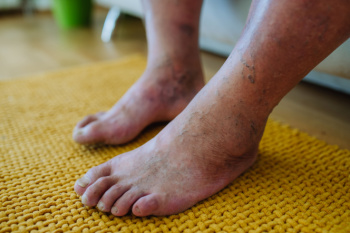
Diabetic foot problems are a serious concern that can affect circulation, nerve function, and skin integrity, often leading to complications, if not addressed promptly. Symptoms include numbness, burning sensations, or slow-healing wounds, and the foot may look dry, discolored, or develop calluses and ulcers. It may feel heavy, sensitive, or painful, particularly with pressure or minor injuries that often go unnoticed due to reduced sensation. Causes are typically linked to high blood sugar levels damaging nerves and blood vessels, poor circulation, and biomechanical stress. A podiatrist can begin with a thorough foot examination, assessing circulation, nerve function, and skin condition while identifying risk factors. Treatment may include wound care, footwear recommendations, and strategies to improve circulation and prevent future complications. Because early intervention preserves foot health and prevents serious issues, it is suggested that you are under the care of a podiatrist who can help you to manage this condition.
Diabetic foot care is important in preventing foot ailments such as ulcers. If you are suffering from diabetes or have any other concerns about your feet, contact Susan Yeager, DPM from Yeager Foot and Ankle Center. Our doctor can provide the care you need to keep you pain-free and on your feet.
Diabetic Foot Care
Diabetes affects millions of people every year. The condition can damage blood vessels in many parts of the body, especially the feet. Because of this, taking care of your feet is essential if you have diabetes, and having a podiatrist help monitor your foot health is highly recommended.
The Importance of Caring for Your Feet
- Routinely inspect your feet for bruises or sores.
- Wear socks that fit your feet comfortably.
- Wear comfortable shoes that provide adequate support.
Patients with diabetes should have their doctor monitor their blood levels, as blood sugar levels play such a huge role in diabetic care. Monitoring these levels on a regular basis is highly advised.
It is always best to inform your healthcare professional of any concerns you may have regarding your feet, especially for diabetic patients. Early treatment and routine foot examinations are keys to maintaining proper health, especially because severe complications can arise if proper treatment is not applied.
If you have any questions, please feel free to contact our office located in Redding, CA . We offer the newest diagnostic and treatment technologies for all your foot care needs.

The shoes worn for running play a large role in how the feet handle repeated force. Because every step places pressure through the heels, arches, and toes, cushioned running shoes can help absorb shock and protect the joints. When shoes lack adequate support, the arches can collapse or roll inward, which may lead to heel pain, shin pain, or irritation of the Achilles tendon. A well-built running shoe keeps the foot aligned, improves ankle stability, and lessens stress on the bones during long distances. People with flat feet, high arches, or neutral arches often benefit from different shoe designs that match their structure. A podiatrist can examine the feet, assess gait, and recommend shoe features that reduce injury risk and keep runners active. If you are experiencing foot pain from running, it is suggested that you schedule an appointment with a podiatrist for a diagnosis and appropriate treatment.
Exercising your feet regularly with the proper foot wear is a great way to prevent injuries. If you have any concerns about your feet, contact Susan Yeager, DPM of Yeager Foot and Ankle Center. Our doctor will treat your foot and ankle needs.
How to Prevent Running Injuries
Many common running injuries are caused by overuse and overtraining. When the back of the kneecap starts wearing out and starts causing pain in your knee, this is commonly referred to as runner’s knee. Runner’s knee is a decrease in strength in your quadriceps and can occur if you’re not wearing properly fitted or supporting shoes. To prevent runner’s knee, focusing on hip strengthening is a good idea, as well as strengthening your quads to keep the kneecaps aligned.
What Are Some Causes of Running Injuries?
- One cause of a common running injury is called iliotibial band syndrome.
- Plantar fasciitis is also another common injury.
- Stress fractures can occur from overtraining, lack of calcium, or even your running style.
Best Ways to Prevent Running Injuries
- Wear footwear that fits properly and suits your running needs.
- Running shoes are the only protective gear that runners have to safeguard them from injury.
- Make a training schedule. Adding strengthening exercises as well as regular stretching can help keep you strong and limber and can lessen the possibility of injuries.
- Stretching keeps muscles limber; this will help you gain better flexibility.
If you have any questions, please feel free to contact our office located in Redding, CA . We offer the newest diagnostic and treatment technologies for all your foot care needs.

Gout is a painful form of inflammatory arthritis caused by a buildup of uric acid crystals in the joints, most commonly affecting the big toe. The pain may be so debilitating that even the weight of a sheet can cause discomfort. Several factors increase the risk of developing gout, including family history, male gender, older age, obesity, and frequent alcohol consumption. These elements can raise uric acid levels and trigger sudden attacks of severe redness, swelling, and intense joint pain. A podiatrist can diagnose gout through examination and testing, provide treatment to reduce inflammation, and offer long-term strategies to prevent future flare ups. Managing foot function and joint health is also essential for comfort and mobility. If you have symptoms of gout, it is strongly suggested that you are under the care of a podiatrist who can help you to manage this painful condition.
Gout is a painful condition that can be treated. If you are seeking treatment, contact Susan Yeager, DPM from Yeager Foot and Ankle Center. Our doctor will treat your foot and ankle needs.
What Is Gout?
Gout is a form of arthritis that is characterized by sudden, severe attacks of pain, redness, and tenderness in the joints. The condition usually affects the joint at the base of the big toe. A gout attack can occur at any random time, such as the middle of the night while you are asleep.
Symptoms
- Intense Joint Pain - Usually around the large joint of your big toe, and it most severe within the first four to twelve hours
- Lingering Discomfort - Joint discomfort may last from a few days to a few weeks
- Inflammation and Redness -Affected joints may become swollen, tender, warm and red
- Limited Range of Motion - May experience a decrease in joint mobility
Risk Factors
- Genetics - If family members have gout, you’re more likely to have it
- Medications - Diuretic medications can raise uric acid levels
- Gender/Age - Gout is more common in men until the age of 60. It is believed that estrogen protects women until that point
- Diet - Eating red meat and shellfish increases your risk
- Alcohol - Having more than two alcoholic drinks per day increases your risk
- Obesity - Obese people are at a higher risk for gout
Prior to visiting your podiatrist to receive treatment for gout, there are a few things you should do beforehand. If you have gout you should write down your symptoms--including when they started and how often you experience them, important medical information you may have, and any questions you may have. Writing down these three things will help your podiatrist in assessing your specific situation so that he or she may provide the best route of treatment for you.
If you have any questions, please feel free to contact our office located in Redding, CA . We offer the newest diagnostic and treatment technologies for all your foot care needs.

